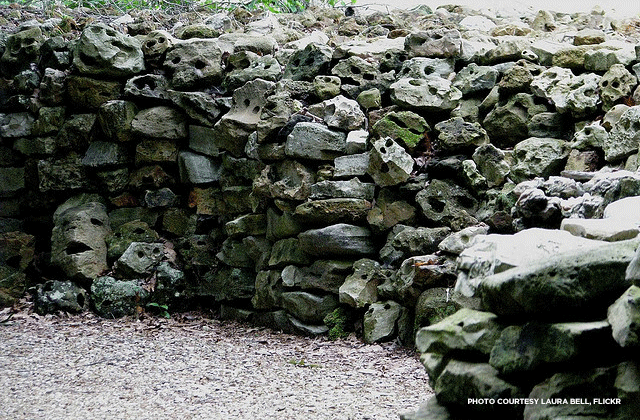Visit the Wichahpi Commemorative Stone Wall in Florence, Alabama

Tom Hendrix has spent the last 30 years building this mile-long monument to his great-great grandmother.
Some retirees take up fly-fishing or gardening. After retiring from a Ford Motor Company aluminum plant in Sheffield, Alabama, in 1983, Tom Hendrix started building a stone wall with his bare hands.
Even though it’s still a work in progress, the Wichahpi Commemorative Stone Wall is currently the largest unmortared wall in the United States, built to memorialize Hendrix’s Native American great-great grandmother, Te-lah-nay. The wall represents Te-lah-nay’s journey back to her homeland after being relocated to Oklahoma on the Trail of Tears following the Indian Removal Act of 1830. Missing the “singing” Tennessee River she had grown up next to in present-day Florence, Alabama, she spent five years retracing her steps, eventually making her way back to her Yuchi tribe’s native land.

Part of the wall incorporates a prayer circle, meant for meditation and reflection by visitors.
Hendrix, now 81, originally drew inspiration for the project from a conversation with a Yuchi woman, who quoted a proverb about honoring ancestors with stones. He now quotes it back to visitors: “We shall all pass through this earth. Only stones remain. We honor our ancestors with stone.”
He had heard stories about Te-lah-nay from his grandmother all his life, and he felt that the wall, with each stone representing a step she took, would be a worthy way to honor her journey.
The wall's shape, height and width changes along its course, representing obstacles Te-lah-nay encountered. Hendrix works eight-to-nine hour days on the project, picking up stones from a local quarry and driving them back to his property in a pickup truck. “I wore out three trucks, 22 wheelbarrows, 3,700 pairs of gloves, three dogs and one old man,” he told the New York Times last year.
Hendrix started constructing the wall on his own property a few miles off the Natchez Trace Parkway, a 444-mile highway that traces an age-old route once used by Native Americans, “Kaintucks” (boatmen who floated goods down the Ohio and Mississippi rivers on flat boats) and settlers.
Stretching from Natchez, Mississippi to Nashville, Tennessee, the parkway winds through historic landmarks and sites such as the site of the Civil War battle of Vicksburg, the Mount Locust plantation, and the Elvis Presley birthplace. The National Park Service describes it as a “drive through exceptional scenery and 10,000 years of American history.”

Most of the wall’s sandstone and limestone come from a local quarry, but visitors have also donated stones over the years.
The wall currently features stones brought by visitors from over a hundred countries and territories, including Saudi Arabia, France, China, New Zealand, and Australia. Hendrix has estimated that 50 to 250 people visit the wall each weekend, despite it not yet being listed as an official stop on the Natchez Trace Parkway heritage trail. He hasn't done much publicity, and doesn't want the wall to become a large tourist attraction -- rather, he believes that if people find out about the wall on their own and make the journey, they were meant to come.
Tourism steadily increased after Hendrix was featured in a 2013 documentary about the legendary Muscle Shoals recording studios, located just a few miles away. In a long-held tradition at the studios, musicians have cited inspiration from the “singing” Tennessee River, an idea that originated with Te-lah-nay’s Yuchi tribe. The Yuchi believed that a woman resided in the waters of the river, giving them guidance and melodies.
Watch Hendrix talk further about the project in these videos. The wall is open daily to visitors.



